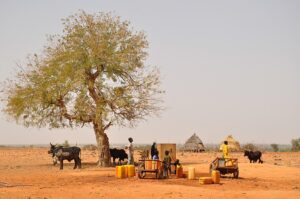By Manvitha Prasad Kathula

Climate change is more than just hotter summers and colder winters. It often leads to mass migration – where people are forced to leave their homes behind as their environment becomes increasingly inhospitable.
In Niger and most of Sub-Saharan Africa, rising temperatures, erratic rainfall, and a significant increase in the population have caused a scarcity of water and other vital resources (like wood) that are necessary for survival. This insufficiency leads to overwhelming competition between groups of people in rural areas, affecting farming and cultivation. The effects of climate change also decrease the likelihood of personal growth in these areas, as people primarily practice agriculture in these regions.
All these factors have contributed to a significant increase in rural-urban migration. According to the United Nations International Organization for Migration, Niger will generate more than 5 million internal migrants by 2050.
Ganso Seniali, a chief of a group of herders from the Tillabéri Region in Niger, recalls how he and most of his village were forced to move to the outskirts of the capital, Niamey. As he states, “The drought where we are originally from has increased conflict between us and sedentary farmers who are sort of fighting over similar resources of land and water, where we want to graze, but the farmers want to grow crops. This sometimes has led to deadly battles, you know, fought with guns, arrows, and machetes.” Although the move was hard on the people and their livestock, after settling in, they continued their normal activities but in an urban setting.
He also reports that life is a little easier in the city. Firstly, there appears to be no severe conflict for resources between people. It is easier for internal migrants to sell their dairy products and receive veterinary care for their herds. He further adds, “We take our cows out in the mornings to graze on the edge of the city where there is a bit of grazing space on the outskirts, and we find extra food for our goats by knocking on doors in town and taking the vegetable scraps that people might otherwise throw out.” Furthermore, the city also provides different job opportunities, enabling Tillabéri migrants to earn more money to take care of their families.
Climate change’s impact on Niger’s environment leads to internal migration. Although migration is disruptive and unwelcome, Nigeriens are modifying and transforming their lives to ensure a better present and future for themselves and the ecosystem. By drilling deep wells, Wells Bring Hope helps alleviate water scarcity, one element of climate change that leads to migration.
Sources:
https://books.google.com/books?hl=en&lr=&id=QWiQDwAAQBAJ&oi=fnd&pg=PA3&dq=niger+and+climate+migration&ots=c-D ozwEeAr&sig=LgIV0dkkSTTnQEavkXSQkDGwiek#v=onepage&q=niger%20and%20climate%20migration&f=false
https://rodakar.iom.int/sites/g/files/tmzbdl696/files/documents/iom-niger-mecc-study-en.pdf


